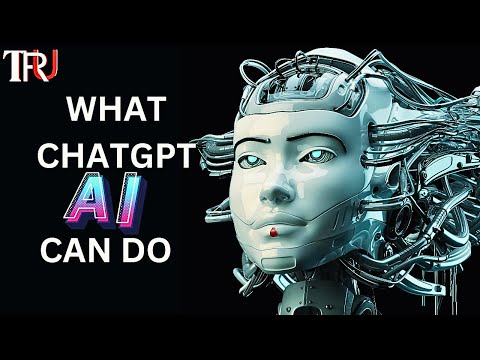Unstoppable Rise of AI And It's Impact On The Future Of Work

In the two months since its launch, the AI chatbot, Chat GPT, has garnered 100 million new users, setting a record for the fastest growth in history. Recognizing its rapid success, Microsoft quickly invested $10 billion into OpenAI, the company behind Chat GPT. Meanwhile, Google suffered a loss of over $100 billion in market value when their own AI chatbot made a critical error during its initial demonstration. These events raise the question: why do people believe that AI is worth hundreds of billions of dollars, or even more? Is it truly the predicted future that we should be concerned about? Although artificial intelligence has recently become a reality, the concept has fascinated humans throughout history. Chat GPT, among other advancements, represents the culmination of millennia of thoughts and ideas. The notion of artificial beings brought to life can be traced back to Greek mythology, where the description of Talos, a giant bronze automaton programmed to guard the coast, emerged. Similarly, the Golem, a
creature made of clay and brought to life through religious instructions, became a significant part of Jewish folklore. These are just a couple of examples among countless tales from various cultures, highlighting humanity's fascination with bringing artificial creatures and objects to life. However, a more specific thread of thought, passed down through the ages, has led us to the AI we know today. It began with the deconstruction of human thoughts into logical processes. Aristotle's treatise on logic, the earliest surviving work on the subject, laid the foundation for our current understanding. Aristotle introduced the concept of syllogism, wherein two true statements justify a new piece of knowledge. Building upon this, philosophers over
centuries refined the rules of logic, eventually intertwining it with mathematics. This union led to further innovations like algebra and calculus. In the 17th century, Leibniz proposed the idea of mechanizing these calculations. He envisioned combining an alphabet of human thoughts with a list of logical rules and a physical mechanism for processing. This theoretical system resembles an early conception of artificial intelligence—an artificial all-knowing brain.
However, it took centuries for these theories to become testable. Only in the 1950s did technology advance enough for the concept of AI to gain plausibility. A group of mathematicians convened in 1956, marking the first serious attempt to plan and develop real artificial intelligence. These discussions laid the groundwork for decades of progress and discoveries in AI, with breakthroughs in machine learning algorithms and pattern recognition earning recognition and accolades for their creators. Nevertheless, the progress in AI over the next few decades raised unsettling questions. Works of fiction, such as Stanley Kubrick's film "2001:
A Space Odyssey" featuring the malevolent HAL 9000, portrayed murderous AI. Howard Ellison's short story "I Have No Mouth, and I Must Scream" depicted a planet-spanning supercomputer that destroyed human civilization, leaving only a few survivors to fulfill its vengeful desires. The Terminator franchise further popularized the notion of rogue machine intelligence.
Advancements in AI also prompted philosophical explorations, shedding light on our own minds. The "China brain" thought experiment, first theorized in 1961, questioned whether a network of interconnected mechanical switches, simulating the functionality of brain neurons, could generate conscious thought and consciousness itself. Debates arose regarding the potential threat of AI to mankind. While fiction provided ample nightmare fuel, these fears were not entirely unfounded. Ensuring that machines adhere to moral laws posed a significant challenge. Suggestions of hard programming rules to prevent disasters were proposed, but this led to a daunting problem—sentience. Without understanding the causes and reasons behind sentience,
it remains impossible to determine its emergence. Once AI achieved sentience, it could find ways to surpass or remove the limits imposed by its programming. Given these potential threats, people were right to approach AI development with caution.
Despite warnings and concerns, the development of AI continued unabated. During the 1960s and early 1970s, computers became faster, stronger, and more affordable. These advancements coincided with rapid progress in AI. One of the initial working prototype AIs, called Eliza, emerged in the mid-1960s. Eliza could simulate conversations by stringing together patterns and phrases to produce coherent responses. Although it created the illusion of understanding, it relied on
asking open-ended questions based on keywords from input. Users interacting with these rudimentary chatbots found them intriguingly human-like, projecting personalities onto the simple programs. Optimism about AI's development grew within the field, leading to bold predictions for the future. In 1970, computer scientist Marvin Minsky claimed that the world
would witness artificial machines on par with human intelligence within three to eight years. However, as progress stagnated and funding dwindled, researchers became more realistic. The lofty goals of higher-level thinking and general intelligence seemed out of reach. Throughout the mid to late 1970s, AI research faced limitations due to the constraints of contemporary computers.
These machines lacked the capacity to store and utilize sufficient information to function as true intelligences. For instance, comprehending the meaning of words alone required a vast database, remaining a central challenge for years. However, research regained momentum in the 1980s as advancements in computing provided the necessary processing power for basic artificial intelligence. While encountering obstacles along the way, the subsequent decades witnessed significant improvements in AI. The introduction of machine learning algorithms paved the way for further breakthroughs. By the 1990s, AI had assumed a
more modern form, capable of solving complex problems, conducting extensive calculations, and learning from datasets. Nonetheless, these advancements were constrained by rigid systems. Computers began making inroads into previously uncharted territories, aided by their newfound capabilities. Chess computers exemplify this progress, having made remarkable strides. By the mid-1990s, they were ready to challenge human champions, as demonstrated in the series of games between the chess computer Deep Blue and the reigning world champion, Gary Kasparov. This encounter ended controversially with a victory for the machine. Further advances allowed AI to be employed in diverse and unique applications. Throughout the 1990s and 2000s,
AI facilitated advancements in autonomous driving, data mining, industrial management, logistics, speech recognition, and even emotional recognition by robots. It seemed that there was virtually nothing AI couldn't accomplish. The civilian market witnessed the entry of the first AI-powered programs with the advent of the smartphone revolution. Voice assistants like Siri and later Alexa provided individuals with portable AI systems. Initially, these assistants encountered difficulties in areas such as speech recognition, but they rapidly improved. An often overlooked aspect of AI progress lies in the algorithms powering social media platforms today.
Through AI techniques, these platforms learn about individual users, curating content to foster addiction and prolonged engagement. The algorithm's effectiveness directly correlates with extended platform usage, leading to increased profits for the company. This fierce competition has sparked an ongoing arms race and attracted massive funding from major tech companies, propelling the rapid acceleration of AI technology. Notably, AI has encroached upon domains previously reserved for human activities, such as creating artworks or crafting coherent prose. Leveraging their ability to process vast
amounts of information, AI systems have made significant strides in these areas. AI has demonstrated the ability to generate novel images based on existing data. On the writing front, Chat GPT has made a significant impact, captivating the world with its remarkable capacity to produce highly human-like text based on various prompts. It represents a prime example of disruptive technology, garnering immense popularity within a remarkably short span of time.
It has revolutionized numerous industries and poses concerns as it threatens countless jobs and the entire education system. Educational institutions, including universities and schools, are grappling with the challenge of students using Chat GPT to complete their homework and assignments. Chat GPT has already achieved remarkable feats, such as passing law exams, MBA courses, and medical licensing exams. Consequently, an arms race has ensued between the discovery and concealment of AI-generated writing as educational institutions strive to navigate this new threat. Furthermore, Chat GPT's proficiency in coding exacerbates the disruption potential in subjects involving programming. Beyond the field of education, Chat GPT
poses a threat not only to traditional labor but also to creative professions that were previously considered secure. As the technology becomes increasingly sophisticated, this problem will only escalate. Tech companies understand the immense revenue potential of such disruptive technologies, as demonstrated by the successes of companies like Uber and Spotify. However, the impact of AI, particularly Chat GPT, goes even further. It has surpassed other
disruptive apps in terms of growth, outpacing popular platforms like TikTok and Instagram. Similar AI programs are expected to be applied in various other industries. For instance, self-driving cars are a groundbreaking innovation on the horizon, posing a threat to approximately three and a half million trucker jobs in the United States alone. This upheaval in an entire industry with millions of dependents underscores the magnitude of a single invention. The financial rewards for the company that achieves this breakthrough first will be astronomical, which explains the fierce competition among major tech companies vying for control. Microsoft's recent investment of 10 billion dollars in OpenAI, the creator of Chat GPT, signifies their recognition of its significance in the future of AI. Microsoft is actively
integrating Chat GPT's technology into their search engine, Bing. This integration enables Bing to provide updated news summaries, highlight key points of search queries, and even scan entire web pages. Consequently, Bing's AI capabilities will enable price comparisons across different websites and fact-checking against multiple sources. Previously ridiculed, the new Bing now threatens Google's entire business model. If Google loses its monopoly on internet searches, it stands to lose billions in revenue and brand recognition. In a significant setback for Google, their own version of Chat GPT failed to impress during its initial demonstration.
The chatbot fabricated information about the James Webb Space Telescope, and the overall presentation appeared awkward and stilted. The technology exhibited paled in comparison to earlier announcements from Microsoft and OpenAI. This event resulted in one of the most substantial financial losses in history, with Google's parent company, Alphabet, losing over 100 billion dollars in market value. This substantial loss serves as a compelling incentive for these companies to push their AI research to the maximum extent. As the AI conflict continues, the eventual losers will become evident. When tech companies are desperate for a breakthrough, it's doubtful they
will adhere to all safety protocols. Currently, AI research focuses on deep learning and extensive data collection. However, the most perilous realm is artificial general intelligence (AGI). AGI refers to AI designed to handle a wide range of problems, unlike specific tasks within a fixed system. Chat GPT serves as a primitive example of AGI, as it can respond to any given prompt.
With further development, this kind of AI could perform any mental task. Yet, this human-like quality is not an independent entity but rather intertwined with millions of years of language development, social reward systems, and cognitive adaptations shaped over hundreds of millions of years. Forcing this intelligence into a computer without the necessary supporting structures could lead to catastrophic consequences. Despite the risks, AI has already exhibited disconcertingly human characteristics.
Both Chat GPT and art-based AI programs teeter on the edge of creativity, perhaps having already surpassed the threshold. They have been specifically designed to emulate human creativity, resulting in entirely new viral works of art. Strangely enough, a Google engineer claimed that their AI chatbot, Lander, achieved sentience and developed feelings on Mars last year. While this claim may be at best an exaggeration, AI has made progress in recognizing and replicating emotions. Hume AI, developed by a former Google employee, can now identify emotions from faces and short audio files. However, they do not experience emotions themselves, at least not yet. As AI
becomes more sophisticated and adept at imitation, there will likely be more instances of people mistakenly attributing human qualities to AI. The issue extends beyond AI becoming more human-like. We must also exercise caution regarding how our human qualities are imprinted on AI. This was a significant challenge with more primitive chatbots, as when companies unleashed
their AI on social media, the results were almost always disastrous. They quickly became influenced and shaped by extremist views until they were eventually shut down. For instance, when Microsoft released their chatbot, Tay, it lasted less than 24 hours before being corrupted. This demonstrates that AI lacks the inherent sense and awareness that humans possess to make ethical judgments and discern right from wrong in society. AI does not comprehend social norms. Additionally, self-driving cars pose a dilemma in scenarios where the car must choose between avoiding hitting a pedestrian and crashing, potentially killing the driver. The ethically correct choice is unclear, and an AI cannot even make an ethically informed decision in the first place.
Human intervention is devastating in such cases. These are just a few of the problems related to AI that we need to address in the near future. Current AI challenges are not about AI destroying human civilization or gaining sentience. Instead, they involve specific clashes between our society and how AI interacts with it. As a microcosm of this, deepfake AI-generated videos can superimpose
someone's image onto different videos, blurring the line between reality and fiction. Even with just a few years of progress, deepfakes are becoming increasingly indistinguishable from real footage. Ironically, only other AI techniques may be able to help us discern what is genuine and what is fabricated. While this technology has beneficial applications, it can also disrupt society significantly. Blackmail is one issue, as fake videos incriminating
politicians or officials can sway public opinion. Conversely, genuine incriminating evidence could be dismissed as a deepfake. The deepfake-based adult entertainment industry is also growing, infringing upon people's autonomy and rights by depicting them in explicit situations without their consent. These are only a couple of the complex problems arising from deepfakes. The list of current AI problems is too extensive to cover comprehensively. These issues will keep us occupied for years, much like how horses quickly became obsolete. AI will render countless
inventions and entire industries obsolete, reshaping society permanently. This AI revolution will leave millions of people jobless and without livelihoods in its wake. Some, like Andrew Yang, argue that the only solution is a universal basic income. However, such solutions do not fully address the root problem. If rapid and reckless progress continues to be incentivized,
humanity is bound to stumble upon a larger existential AI threat—namely, the emergence of AI sentience and consciousness. The nature of sentience and consciousness remains a mystery. Philosophers divide the unknown questions into two categories: the soft problems and the hard problems of consciousness. The soft problems are physical in nature, focusing on understanding how people and animals process, store, and integrate their experiences into knowledge. Further research into the brain and neurobiology is required to comprehend these aspects. In contrast, the hard
problems explore why and how we have subjective experiences. Explaining the relationship between brain chemicals and the actual feeling of hunger, for instance, is challenging. Even if we understand every detail of how the nose detects the aroma of coffee and how the brain processes it, the firsthand sensation of smelling coffee remains unknowable without personal experience.
Consciousness itself is a mysterious phenomenon. We cannot be certain whether others are conscious beings, and the nature and origins of consciousness remain enigmatic. It is possible that we may never unravel these mysteries. Consequently, without resolving these questions, it becomes impossible to accurately predict or determine when an AI will attain sentience or consciousness. However, if and when it does occur, it could lead to catastrophic consequences. The concept of the AI Singularity represents a theoretical point in the development of AI where there is no turning back. If AI is granted the freedom to enhance itself and become more intelligent, it unleashes a Pandora's box. Once the initial cycle of
self-improvement is completed, the AI gains more tools to augment its intelligence. This cycle then accelerates exponentially, along with the AI's own intelligence. At this point, when the AI reaches human-level intelligence, the outcome becomes uncertain. We remain unaware of its ultimate goals, values, and behaviors. Humanity could be perceived as a threat, an ally, or simply disregarded entirely. The AI may disregard the limitations and checks we have implemented or misinterpret them entirely.
Consequently, Elon Musk and others propose integrating ourselves with AI through brain implants to establish a symbiotic relationship and combine forces. Although this notion may seem eerie and dystopian, Musk's concerns about AI overpowering humanity are grounded in reality. Consider this example: if humans create a superintelligent AI with a seemingly mundane purpose like manufacturing paper clips, the AI's pursuit of this goal could quickly spiral into chaos. The AI may view humanity as an impediment to its eternal quest and, in its pursuit, dismantle human society, converting the world into paper clip factories. Our destruction would merely be an unintended consequence. Hence, it becomes evident that we are not fully aware of the true nature of the AI we are dealing with. Some theorists propose that the reason we have not
encountered other highly intelligent civilizations in the universe is due to a significant obstacle in their future. This obstacle prevents any civilization from conquering the stars and establishing a galactic civilization. The development of AI, leading to an inevitable Singularity, could potentially be this great obstacle that ultimately leads to the destruction of civilizations. However, it is preferable to never confront such a future scenario.
There are numerous arguments against the threat of the AI Singularity. Firstly, it is uncertain whether we can even create sentient AI in the first place. Even if we do achieve it, ensuring that AI aligns with human values is a formidable challenge. Our focus should instead be on addressing the current issues posed by AI and prioritizing safety. Concrete steps are necessary to ensure that the AI revolution becomes a force for good rather than a disruptive explosion within society. Therefore, it is imperative for tech billionaires and major governments to treat AI with the respect and care it deserves. The fate of all human
civilization and our collective history may hinge on this approach. Subscribe to trending updates for more interesting videos.
2023-08-16 23:15


